This two-storey building was a bakery for many years. It was established by BF Done, in 1867, and passed down through several generations of the family. The premises are now named after the former Royal Tiger public house which occupied the premises next door during 1875–1993. Its unusual name is thought to be connected with the manufacture of animal and man traps, for which Wednesfield was once well known.
Prints and text about the Battle of Wednesfield.
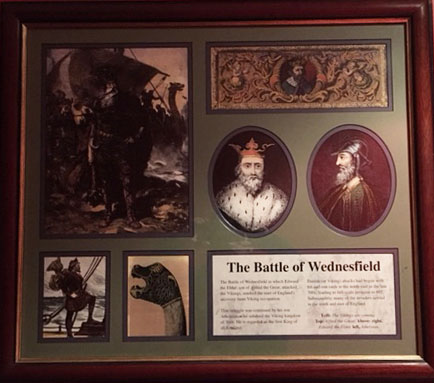
The text reads: The Battle of Wednesfield in which Edward the Elder; son of Alfred the Great, attacked the Vikings, marked the start of England’s recovery from Viking occupation.
This struggle was continued by his son Athelstan, who subdued the Viking kingdom of York. He is regarded as the first King of all England.
Danish (or Viking) attacks had begun with hit and run raids in the north east in the late 700s, leading to full scale invasion in 865. Subsequently, many of the invaders settled in the north and east of England.
Left: The Vikings are coming
Top: Alfred the Great
Above: right, Edward the Elder, left, Athelstan.
Illustrations and text about Woden’s Field.
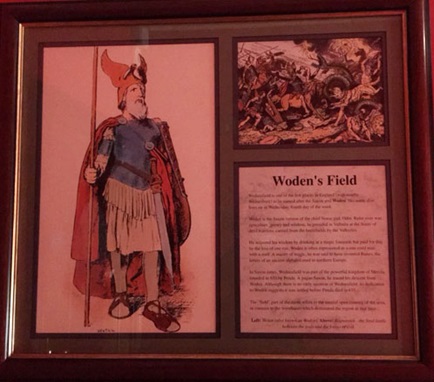
The text reads: Wednesfield is one of the few places in England (with nearby Wednesbury) to be named after the Saxon god Woden. His name also lives on in Wednesday, fourth day of the week.
Woden is the Saxon version of the chief Norse god, Odin. Ruler over war, agriculture, poetry and wisdom, he presided in Valhalla at the feasts of dead warriors, carried from the battlefields by the Valkyries.
He acquired his wisdom by drinking at a magic fountain, but paid for this by the loss of one eye. Woden is often represented as a one-eyed man with a staff. A master of magic, he was said to have invented Runes, the letters of an ancient alphabet used in northern Europe.
In Saxon times, Wednesfield was part of the powerful kingdom of Mercia, founded in 633 by Pena. A pagan Saxon, he traced his descent from Woden. Although there is no early mention of Wednesfield, its dedication to Woden suggests it was settled before Penda died in 655.
The ‘field’ part of the name refers to the natural open country of the area, in contrast to the woodlands which dominated the region at the time.
Illustrations and text about Moseley Old Hall.
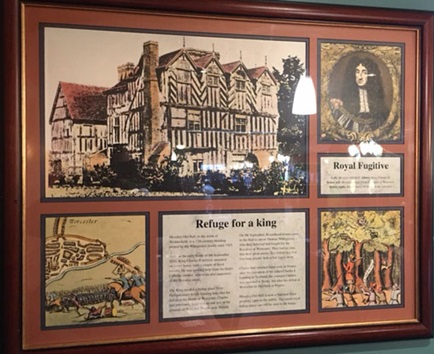
The text reads: Moseley Old Hall, to the north of Wednesfield, is a 17th century building owned by the Whitgreave family until 1925.
Here, in the early hours of 8 September 1651, King Charles II arrived, mounted on a cart-horse, with a couple of loyal escorts. He was seeking help from the hall’s Catholic owners, who were also supporters of the Royalist cause.
The King needed a hiding place from Parliamentary troops hunting him after his defeat at the Battle of Worcester. Charles had previously hidden in an oak tree in the grounds of Boscobel House, near Shifnal.
On the 9 September, Roundhead troops came to the hall to arrest Thomas Whitgreave, who they believed had fought for the Royalists at Worcester. They had no idea that their great enemy was hiding in a five foot long priests’ hole a few yards away.
Charles had returned from exile in France after the execution of his father Charles I. Landing in Scotland, the younger Charles was crowned at Scone, but after his defeat at Worcester he fled back to France.
Moseley Old Hall is now a National Trust property, open to the public. The secret royal hiding place can still be seen in the house.
Left: Moseley Old Hall
Above: King Charles II
Below left: Royalist retreat from the Battle of Worcester
Below right: King Charles II hiding in the oak tree.
Prints and text about the Essington and Wyrley Canal.
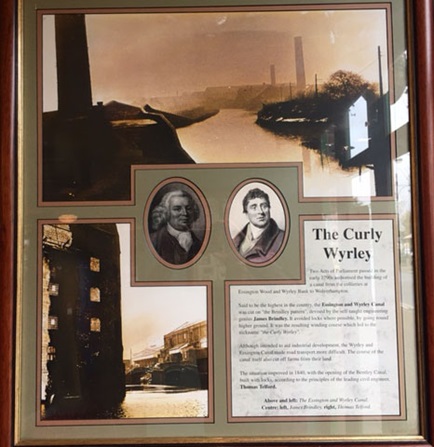
The text reads: Two Acts of Parliament passed in the early 1790s authorised the building of a canal from the collieries at Essington Wood and Wyrley Bank to Wolverhampton.
Said to be the highest in the country, the Essington and Wyrley Canal was cut on the Brindley pattern, devised by the self-taught engineering genius James Brindley. It avoided locks where possible, by going round higher grounds. It was the resulting winding course which led to the nickname the ‘Curly Wyrley’.
Although intended to aid industrial development, the Wyrley and Essington Canal made road transport more difficult. The course of the canal itself also cut off farms from their land.
The situation improved in 1840, with the opening of the Bentley Canal, built with locks, according to the principles of the leading civil engineer, Thomas Telford.
Above and left: The Essington and Wyrley Canal
Centre: left, James Brindley, right, Thomas Telford.
A print, illustrations and text about locks, keys and animal traps.
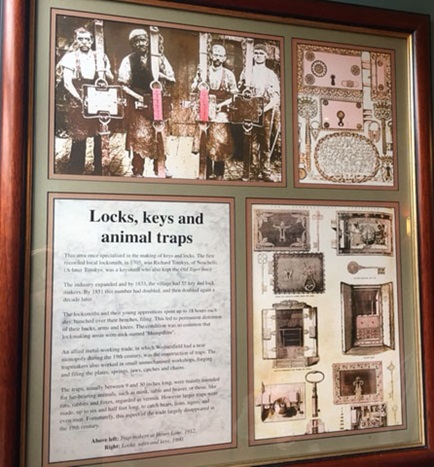
The text reads: This area once specialised in the making of keys and locks. The first recorded local blacksmith, in 1703, was Richard Tomkys, of Neachells. (A later Tomkys was a key smith who also kept the Old Tiger Inn.)
The industry expanded and by 1833, the village had 55 key and lock makers. By 1851 this number had doubled, and then doubled again a decade later.
The locksmiths and their young apprentices spent up to 18 hours each day, hunched over their benches, filing. This led to permanent distortion of their backs, arms and knees. The condition was so common that lock making areas were nick-named ‘Humpshire’.
An allied metal-working trade, in which Wednesfield had a near monopoly during the 19th century, was the construction of traps. The trap makers also worked in small unmechanised workshops, forging and filing the plates, springs, jaws, catches and chains.
The traps, usually between 9 and 30 inches long, were mainly, intended for fur-bearing animals, such as mink, sable and beaver, or those, like rats, rabbits and foxes, regarded as vermin. However larger traps were made, up to six and half feet long, to catch bears, lions, tigers, and even men. Fortunately, this aspect of the trade largely disappeared in the 19th century.
Above left: Trap makers at Henry Lane, 1912
Right: Locks, safes and keys, 1890.
A photograph of Wood End Road, Wednesfield, c1910.
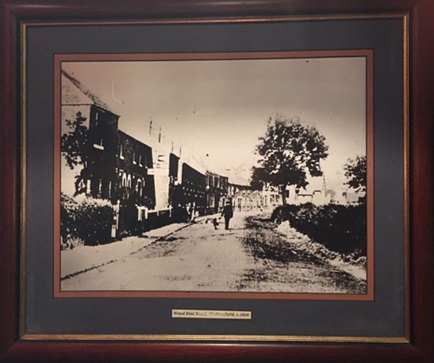
A photograph of workers making locks at the Chubb factory.
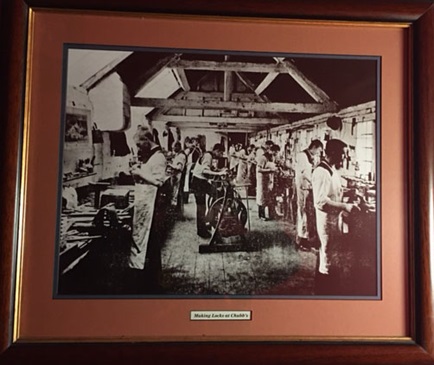
A photograph of a Lorain tram, High Street, Wednesfield, c1910.
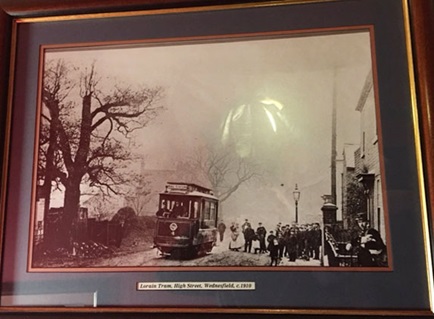
A photograph of a Lorain tram, High Street, Wednesfield, c1910.
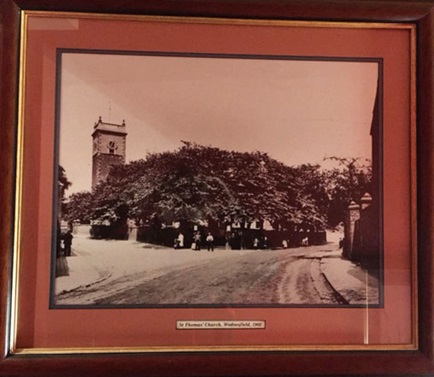
If you have information on the history of this pub, then we’d like you to share it with us. Please e-mail all information to: pubhistories@jdwetherspoon.co.uk